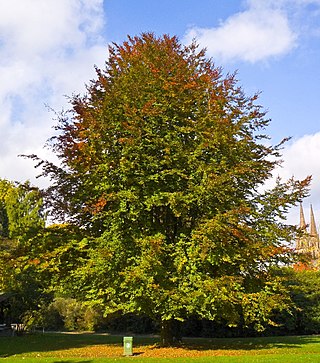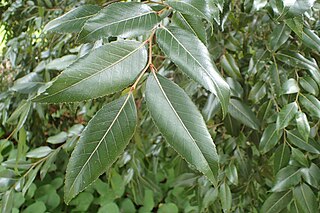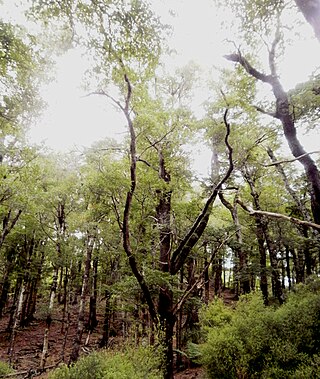
The Fagaceae are a family of flowering plants that includes beeches, chestnuts and oaks, and comprises eight genera with about 927 species. Fagaceae in temperate regions are mostly deciduous, whereas in the tropics, many species occur as evergreen trees and shrubs. They are characterized by alternate simple leaves with pinnate venation, unisexual flowers in the form of catkins, and fruit in the form of cup-like (cupule) nuts. Their leaves are often lobed, and both petioles and stipules are generally present. Their fruits lack endosperm and lie in a scaly or spiny husk that may or may not enclose the entire nut, which may consist of one to seven seeds. In the oaks, genus Quercus, the fruit is a non-valved nut called an acorn. The husk of the acorn in most oaks only forms a cup in which the nut sits. Other members of the family have fully enclosed nuts. Fagaceae is one of the most ecologically important woody plant families in the Northern Hemisphere, as oaks form the backbone of temperate forest in North America, Europe, and Asia, and are one of the most significant sources of wildlife food.

Nothofagus, also known as the southern beeches, is a genus of 43 species of trees and shrubs native to the Southern Hemisphere in southern South America and east and southeast Australia, New Zealand, New Guinea, and New Caledonia. The species are ecological dominants in many temperate forests in these regions. Some species are reportedly naturalised in Germany and Great Britain. The genus has a rich fossil record of leaves, cupules, and pollen, with fossils extending into the late Cretaceous period and occurring in Australia, New Zealand, Antarctica, and South America.

The Valdivian temperate forests (NT0404) is an ecoregion on the west coast of southern South America, in Chile and Argentina. It is part of the Neotropical realm. The forests are named after the city of Valdivia. The Valdivian temperate rainforests are characterized by their dense understories of bamboos, ferns, and for being mostly dominated by evergreen angiosperm trees with some deciduous specimens, though conifer trees are also common.

Nothofagus pumilio, the lenga beech, is a deciduous tree or shrub in the Nothofagaceae family that is native to the southern Andes range, in the temperate forests of Chile and Argentina to Tierra del Fuego, from 35° to 56° South latitude. This tree is in the same genus as the coihue. It regenerates easily after fires. The wood is of good quality, moderate durability, and is easy to work with. It is used in furniture, shingles and construction and sometimes as a substitute for American black cherry in the manufacturing of cabinets.

Nothofagus cunninghamii, commonly known as myrtle beech or Tasmanian myrtle, is the dominant species of cool temperate rainforests in Tasmania and Southern Victoria. It has low fire resistance and grows best in partial shade conditions.

Nothofagus gunnii, the tanglefoot or deciduous beech, is a deciduous shrub or small tree endemic to the highlands of Tasmania, Australia. It was described in 1847 by R.C Gunn N. gunnii is a small woody tree with a shrubby appearance known to grow up to 8 metres (26 ft). It lives only on mountains due to temperature limitations within the Tasmanian maritime climate and mainly grows at altitudes greater than 800 metres (2,600 ft) above sea level. It grows in alpine and sub-alpine regions in the central portions of the island. Though capable of reaching the size of a small tree, it is most common as a thick shrub or woody ground cover, hence its common name of "tanglefoot".

Nothofagus moorei, commonly known as Antarctic beech, is an important Gondwana relict of the rainforests of the southern hemisphere. It occurs in wet, fire-free areas at high altitude in eastern Australia.

Gomortega keule is a species of tree endemic to Chile. It is the sole species of the genus Gomortega and, according to the APG IV system of 2016, of the monotypic family Gomortegaceae, assigned to the order Laurales in the clade magnoliids.

Los Ruiles National Reserve is a small nature reserve located in Cauquenes Province of Maule Region in central Chile. The reserve consists of two sections that protect enclaves of native forest, which are home to several threatened and endangered species.

Nothofagus fusca, commonly known as red beech is a species of southern beech, endemic to New Zealand, occurring on both the North and South Island. It is generally found on lower hills and inland valley floors where soil is fertile and well drained. In New Zealand the species is called Fuscospora fusca.

Nothofagus menziesii, commonly known as silver beech, is a tree of the southern beech family endemic to New Zealand. Its common name probably comes from the fact that its bark is whitish in colour, particularly in younger specimens. It is found from Thames southwards in the North Island, and throughout the South Island. Silver beech is a forest tree up to 30 m tall. The trunk, which is often buttressed, may be up to 2 m in diameter. The leaves are small, thick and almost round in shape, 6 to 15 mm long and 5 to 15 mm wide with rounded teeth which usually occur in pairs, 1 or 2 hair fringed domatia are found on the underside of each leaf. Its Māori name is tawhai. It grows from low altitudes to the mountains. Nothofagus menziesii was proposed to be renamed Lophozonia menziesii in 2013.

Nothofagus truncata, or hard beech, is a species of tree endemic to New Zealand. Its common name derives from the fact that the timber has a high silica content, making it tough and difficult to saw. Hard beech is a tree up to 30m tall occurring in lowland and lower montane forest from latitude 35°S to 42°30'S, that is, from the north of the North Island southwards to Marlborough and south Westland in the South Island. In Taranaki it forms almost pure stands on the rugged sandstone country there and is partially deciduous, dropping many of its leaves at the end of the winter. N. truncata became known as Fuscospora truncata after 2013 in New Zealand.

Nothofagus alpina, also called rauli or raulí beech is a species of plant in the Nothofagaceae family. A deciduous tree, it grows in Chile and Argentina, it reaches 50 m (160 ft) height and more than 2 meters (6.5 feet) in diameter. Its distribution goes from 35 to 42° South latitude. It is found on the Andes. It tolerates low temperatures and heavy winds. It has a straight and cylindrical trunk with grey bark. N. alpina was proposed to be renamed Lophozonia alpina in 2013.

Nothofagus glauca, commonly known as hualo or roble Maulino, is a species of plant in the family Nothofagaceae. It is a deciduous tree endemic to Chile. It grows from 34° to 37° South latitude. It is a typical tree of the maritime mediterranean-climate Maulino forest of Central Chile, its current range spanning over 330 km from north to south. The species grows on a variety of soils and is mostly found on gentle to steep slopes.
Nothofagus stylosa is a species of plant in the family Nothofagaceae. It is endemic to West Papua (Indonesia). It is a Critically Endangered species threatened by habitat loss.

Nothofagus obliqua, commonly known as Patagonian oak, roble, pellín, roble pellín, and hualle in its early state of growth or roble beech, is a deciduous tree from Chile and Argentina. It grows from 33 to 43° south latitude. The northern extent of this tree's range in Chile is considered to be the Vizcachas Mountains and La Campana National Park. N. obliqua was proposed to be renamed Lophozonia obliqua in 2013.

Los Queules National Reserve is a national reserve of Chile. It covers an area of 1.47 km2 in the Chilean Coastal Range. The reserve ranges from 400 to 500 meters in elevation.

Nothofagus cliffortioides, commonly called mountain beech, is a species of Southern beech tree and is endemic to New Zealand. Mountain beech grows in mountainous regions at high elevations. In New Zealand the taxon is called Fuscospora cliffortioides. Nothofagus cliffortioides occupies a wider range of habitat than any other New Zealand tree species and it shows a corresponding range of life form, seeding habits, regenerative patterns, growth habits, growth rates, stand replacement and mortality patterns.

Maulino forest is a forest type naturally growing in the Chilean Coast Range of Central Chile from latitude 35°55 to 36°20 S. The forest grows in the transition zone between Mediterranean climate and humid temperate climate. Precipitation varies from 1000 to 700 mm/a and is concentrated in winter. According to geographers Humberto Fuenzalida and Edmundo Pisano the forest is one of mesophytes on the transition zone of temperate rain forests.
Nothofagus × leoni is a hybrid tree in the family Nothofagaceae. It is a naturally-occurring interspecific hybrid of Nothofagus glauca and Nothofagus obliqua which is endemic to central Chile. It is a characteristic tree of the Maulino forest, a plant community of the Chilean Coast Range.

















